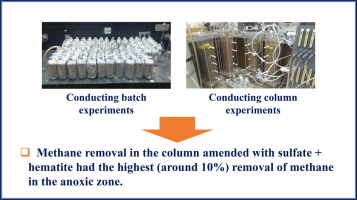Waste Management ( IF 8.1 ) Pub Date : 2020-03-14 , DOI: 10.1016/j.wasman.2020.03.009 Niloofar Parsaeifard , Melanie Sattler , Bahareh Nasirian , Victoria C.P. Chen

|
Landfills are the third largest anthropogenic source of the greenhouse gas methane worldwide. In the upper portions of landfill covers, methane is oxidized aerobically by microorganisms to form the less-potent greenhouse gas carbon dioxide; however, because of the low permeability of oxygen, no aerobic oxidation occurs in deeper portions of the cover. Therefore, the goal of this study was to enhance anaerobic oxidation of methane (AOM) in the deeper parts of landfill covers, to increase overall methane removal, via addition of electron acceptors besides oxygen.
In batch tests, landfill cover soil was amended using five alternate electron acceptors: iron(III), nitrate, nitrite, sulfate, and manganese. AOM was then measured via column tests, which included realistic conditions of gas flow, cover thickness, and compaction.
In the batch tests, soils amended with nitrate, sulfate, and the combination of sulfate + hematite removed more methane compared to control soil. Methane generation inhibitor had no impact on net methane removal. Adding nutrients to the soil significantly enhanced methane removal only for the case of soil without electron acceptors. Greater methane removal was observed for reactors with higher initial methane concentration.
Results of the column tests showed that soil amended with sulfate + iron had the highest (around 10%) removal of methane in the anoxic zone, followed by soil amended with sulfate. Hydrogen sulfide (H2S) gas was measured in the headspace of these two columns, which indicated that sulfate-reducing bacteria were likely responsible for methane removal.
中文翻译:

增强城市固体垃圾填埋场覆盖土壤中甲烷的厌氧氧化
垃圾填埋场是全球温室气体的第三大人为来源。在垃圾掩埋场的上部,甲烷被微生物好氧地氧化,形成低效的温室气体二氧化碳。然而,由于氧气的低渗透性,在盖的较深部分没有发生好氧氧化。因此,这项研究的目的是通过除氧之外还添加电子受体,来提高垃圾掩埋区较深部分的甲烷厌氧氧化(AOM),以提高整体甲烷去除率。
在分批测试中,使用五个备用电子受体(铁(III),硝酸盐,亚硝酸盐,硫酸盐和锰)对填埋场覆盖土壤进行了修正。然后通过柱测试测量AOM,其中包括气流的实际条件,覆盖层厚度和压实度。
在分批测试中,与对照土壤相比,土壤中添加了硝酸盐,硫酸盐和硫酸盐+赤铁矿的组合去除了更多的甲烷。甲烷生成抑制剂对净甲烷去除没有影响。仅在没有电子受体的土壤中,向土壤中添加养分可显着提高甲烷的去除率。对于具有较高初始甲烷浓度的反应器,观察到更高的甲烷去除率。
柱试验的结果表明,在缺氧区中,用硫酸盐+铁改性的土壤对甲烷的去除率最高(约10%),其次是用硫酸盐改性的土壤。在这两个色谱柱的顶部空间中测量了硫化氢(H 2 S)气体,这表明硫酸盐还原细菌可能是甲烷去除的原因。



























 京公网安备 11010802027423号
京公网安备 11010802027423号